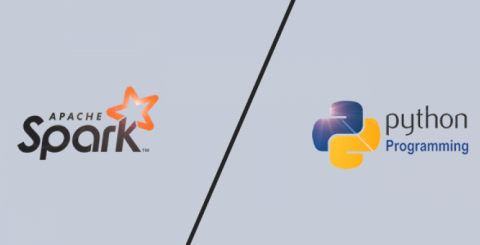Apache Spark with Python: Why use PySpark?

Predictions regarding weather, house prices, and gold rates have largely been accurate in past years due to a scarcity of proper data. However, today, with rampant digitization clouding every sphere of human life, the story is different. Your Facebook feeds, smart watches, Instagram stories, Tesla cars, and all other devices connected to the network are a source of data to engineers and scientists. Nonetheless, storing and processing this data to help us make sense of where the world is going as a whole is a different ballgame altogether. If you are a developer, you will have probably grimaced and chuckled at the sheer scale of this job.
The good news is - Apache Spark was developed to simplify this very problem.
What is Apache Spark?
Developed at the AMPLab in University of California, Berkeley, Spark donated to the Apache Foundation as an open source distributed cluster computing framework. In 2014, after Spark's first release, it gained popularity among Windows, Mac OS, and Linux users. Written in Scala, Apache Spark is one of the most popular computation engines that process big batches of data in sets, and in a parallel fashion today. Apache Spark Implementation with Java, Scala, R, SQL, and our all-time favorite: Python!
What is PySpark?
PySpark is the Python API (Application Program Interface) that helps us work with Python on Spark. Since Python became the fastest upcoming language and proved to sport the best machine learning libraries, the need for PySpark felt. Also, since python supports parallel computing, PySpark is simply a powerful tool. While some say PySpark is notoriously difficult to maintain when it comes to cluster management and that it has a relatively slow speed of user-defined functions and is a nightmare to debug, we believe otherwise.
Why use PySpark?
Coming to the big question, let us look at a few aspects of PySpark that gives it an edge. Before we dive deep into points, remember that PySpark does in-memory, iterative, and distributed computation. It means you need not write intermediate results into the memory from the disk and vice versa every time you write an iterative algorithm. It saves memory, time, and sanity. Are you not in love already?
Easy integration with other languages
Java, R, Scala – you name it, and there’s an easy, ready to pull API waiting for you patiently in the Spark engines. No need to transfer byte codes from here to there, start coding in your mother language (Python doesn’t count!). The object-oriented approach of PySpark makes it an absolute delight to write reusable code that can later test on mature frameworks.
‘Lazy execution’ – something everyone loves about PySpark – allows you to define complex transformations without breaking a sweat (all hail object orientation). Also, if you used to write bad codes, PySpark is going to be your end – not literally. Your bad code would fail fast, thanks to Spark error checks before execution.
Resilient Distributed Datasets
Fault tolerant and distributed in nature, RDD had been tougher to work with until PySpark came into the picture. RDDs are used by PySpark to make MapReduce operations simple. MapReduce is a way of dividing a task into batches that can be worked on in a parallel manner. Hadoop – the gazillion-year old alternative to Apache Spark – uses 90% of its time in writing and reading data in Hadoop Distributed File System. Thanks to RDD in Spark, in-memory calculations are now possible, reducing the time spent on reading and write operations into half.
An open source community
You must be already whooping in joy!
An open source community means an unfathomable number of developers all around the world working to better the technology. Since PySpark is open source, a huge number of people all around the world are contributing to maintaining and developing its core. A great example would be that of the Natural Language Processing library in Spark developed by a team at John Snow Labs. Say goodbye to user-defined functions! An open source community almost guarantees future development and advancement of the engine.
Looking for great speed?
You’re at the right place. PySpark is known for its amazing speed as compared to its contemporaries.
Let’s talk about transformations. Ever tried pivoting in SQL? As hard as it is in there, Spark makes it surprisingly easy. Use a ‘groupBy’ on the target index columns, pivot, and execute the aggregation step. And voila, you’re done!
The ‘map-side join’ is also an amazing feature which cuts time when joining two tables – especially when one of them is significantly larger than the other. The algorithm sends the small table values to data nodes of the bigger table to cut down the hassle. If you realize, the skew also minimized with this method.
In the light of these inherent and constantly-evolving features, Spark can surely be called an attractive tool – PySpark being the cherry on top. While Hadoop has dominated the market for quite some time, it is slowly going to its grave. Thus, if you are getting started with big data and are ready to dive into the mysterious world of artificial intelligence, start with Python, and top the results by adding PySpark to your list.
Similar Articles
When evidence seals fail, cases weaken. Explore how compromised chain of custody can derail investigations and jeopardize justice.
Compare hydraulic and traction residential elevators to find the best fit for your home. Learn how each system works, their pros and cons, space needs, energy use, and maintenance requirements.
Extend the lifespan of your commercial marina docks with proactive maintenance. Learn essential inspection routines, material-specific care, and safety tips to protect your investment and ensure long-term dock performance.
Learn the key factors in designing an engineered fall protection system. Discover how hierarchy of controls, task analysis, structural integrity, and fall clearance ensure safety and compliance.
Today, modern businesses face constant pressure to operate with maximum efficiency. This requires a technology infrastructure that is both agile and robust. However, the traditional model of on-premises data centers often has significant limitations. These legacy systems can drain valuable resources from teams.
When people are hungry, standing in line for a table feels tiring and unpleasant. In fact, research shows that most individuals will just walk away if they have to wait longer. They will go and find another place to eat.
In the early stages of designing new community centers, fire stations and administration buildings, city planners and architects are forced to make a crucial decision: What building material is best suited for providing the most value, safety and longevity to the public?
Amazon Simple Queue Service (SQS), Simple Notification Service (SNS), and EventBridge are just a few of the messaging services that AWS provides to meet various demands when it comes to creating scalable and effective cloud systems.
Wearable technology, embracing devices small enough to be worn unobtrusively, constitutes a market that keeps expanding, and the momentum shows little sign of slowing









